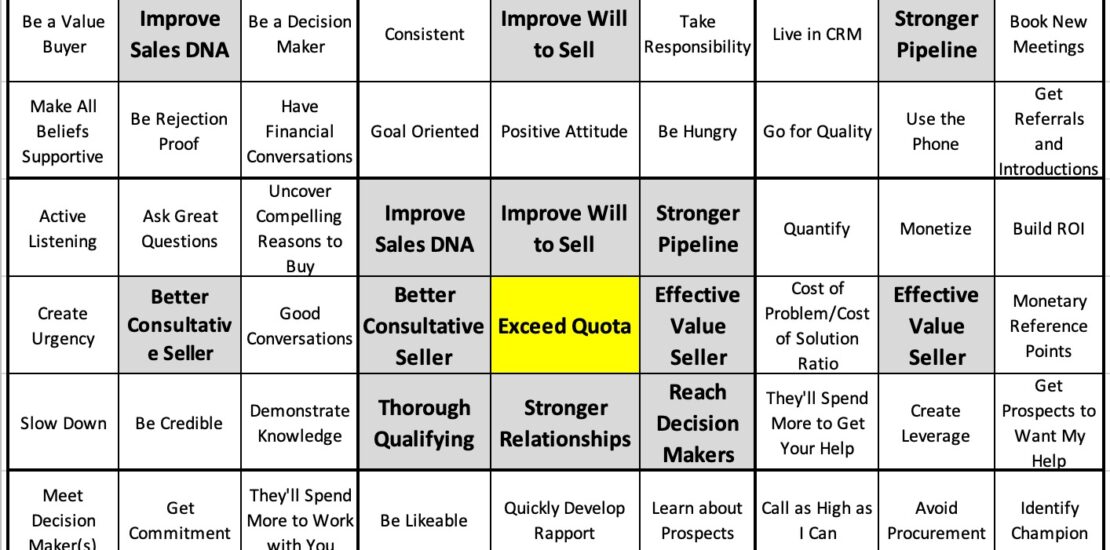sales process
-
Baseball, The Toad and Coaching Unresponsive Salespeople
- April 11, 2024
- Posted by: Dave Kurlan
- Category: Understanding the Sales Force

Coaching salespeople is challenging. When they aren’t responsive to coaching it’s not only more difficult, it is downright frustrating. When you’re attempting to coach unresponsive salespeople to use the phone to directly talk with a decision maker, there isn’t much upside. Whether you’ve made this coaching attempt one time or one hundred times, the outcome will be the same, so the question we should be asking is, should this salesperson still be working for you?
-
250 Best Articles on Sales and Sales Leadership by Category
- April 4, 2024
- Posted by: Dave Kurlan
- Category: Understanding the Sales Force

These are the top 10 articles in 25 categories on sales, sales leadership, sales assessments, sales performance, sales excellence, sales process and more.
-
Homicide Detective Makes Best Case for Sales Process
- March 21, 2024
- Posted by: Dave Kurlan
- Category: Understanding the Sales Force

The author admits that until he conducted his “cold-case investigation” of the New Testament, he was an atheist who always followed the evidence to find the truth. Similarly, a lot of prospects are also non-believers – not necessarily in Jesus – in your product or service. As I read and learned about the author’s methods for uncovering truth, or proof, I felt that salespeople could learn a lot about proof of concept, presenting facts, backing up claims, return on investment, and offering credible testimonials. That’s not nearly the analogy I’m going to make.
Wallace shared a story in the Forward about the time he was shot by a criminal who was on parole, and was not allowed to have a firearm. Up until the moment of the shooting, Wallace believed that a bullet-proof vest would stop a bullet. In the moment of the shooting, he believed in the bullet proof vest. At that moment his belief changed from “belief that” to “belief in.” That was the analogy he wished to apply to the gospels. He wondered if he could find the evidence to replace faith (belief that the miracles occurred) with proof (belief in both Jesus and the miracles).
That also happens to be my analogy from the book. Most salespeople believe that a sales process can help them succeed while the very best salespeople believe in their sales process.
-
Opportunity Blindness – What’s in Your Sales Pipeline?
- February 28, 2024
- Posted by: Dave Kurlan
- Category: Understanding the Sales Force

Some observations:
The data represents the forecast and funnel for 7 sales teams.
The gaps (A & G) are backwards and should say 72% (A) and 41% (G).
The quarterly forecast (C) is 58% short of the quarterly target (D).
The current closable opportunities (B) are 77% short of the forecast (C) and 90% short of the quarterly target (D).
Add columns G and H and together, all of those columns represent pathetic, old news.The question that should be asked is, “What can we do about this?”
We should be able to answer that question by looking at column F but that’s not possible. Can you see why?
Outside of telling us that there isn’t enough in the funnel, the data in column F doesn’t answer the question that must always be asked: Is the pipeline viable?
We know the assigned value of the pipeline but we don’t know the answers to these additional ten important factors:
-
25 Sales Experts on the Importance of Coaching Salespeople
- February 25, 2024
- Posted by: Dave Kurlan
- Category: Understanding the Sales Force

Sales managers are still not coaching – at least not consistently or effectively. As a reminder, consistent daily coaching increases revenue by 28% and when it is paired with effective coaching, revenue increases by 43%. It’s simply incomprehensible that sales managers aren’t picking up the clue phone.
-
Don Kent and My 8 Reasons For Inaccurate Sales Forecasts
- February 15, 2024
- Posted by: Dave Kurlan
- Category: Understanding the Sales Force

1960’s Don Kent is like a 2020’s salesperson. Excited about an opportunity, but wrong. And they don’t have to be wrong, shouldn’t be wrong, and honestly, can’t be wrong. The 2020’s salesperson may not have computer models, but they do have technology and it’s not the technology getting the forecast wrong. It’s the salesperson. There are a number of reasons they get so excited and get it so wrong but here are eight good ones:
-
Whipped Cream! The Easiest Way to Lower Sales Resistance
- February 13, 2024
- Posted by: Dave Kurlan
- Category: Understanding the Sales Force

Most sales training fails to address the single most important condition of a sales cycle – resistance – thereby rendering the sales training semi-useless. When resistance appears, it does not matter if the sales process, methodology, tactics and strategies are good or even great, unless salespeople are equally great at lowering the resistance.
-
Sales Process for the Anti-Sales Process Crowd
- January 31, 2024
- Posted by: Dave Kurlan
- Category: Understanding the Sales Force

You can look at sales process any way you want but if what you want are more consistent, predictable results, in a framework that supports sales coaching, then you want a customized, formal, milestone-centric, customer-focused sales process and scorecard!
-
Wouldn’t Sales Call Play-by-Play Analyses be Fun?
- January 27, 2024
- Posted by: Dave Kurlan
- Category: Understanding the Sales Force

Most sales managers protect their salespeople instead of pushing them to improve. Most companies set budgets that formulaically increase year-over-year budgets by just 3.5%. The sales recruiting process and selection criteria at most companies are horrible. Most sales training is product-focused instead of sales development. Most salespeople are not consistently or effectively coached. Most senior sales leaders are indifferent about doing anything about those things.
-
Combining Goal Setting with Sales Competencies
- January 4, 2024
- Posted by: Dave Kurlan
- Category: Understanding the Sales Force

Allow me to introduce the first draft of the first innovation of 2024 from Kurlan & Associates: The Sales Goals Grid, which incorporates most of the 21 Sales Core Competencies. It is a great visual for every salesperson, regardless of what they sell, who they sell for, who they sell to, or the length of their sales cycle. You can even adapt it to your own needs.

